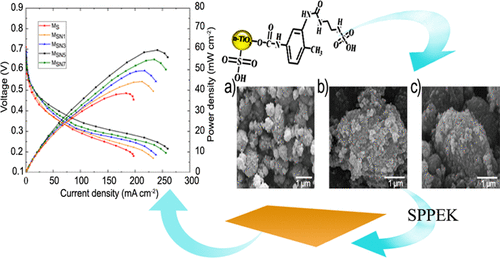当前位置:
X-MOL 学术
›
Ind. Eng. Chem. Res.
›
论文详情
Our official English website, www.x-mol.net, welcomes your
feedback! (Note: you will need to create a separate account there.)
Enhancing the Performance of Poly(phthalazinone ether ketone)-Based Membranes Using a New Type of Functionalized TiO2 with Superior Proton Conductivity
Industrial & Engineering Chemistry Research ( IF 3.8 ) Pub Date : 2020-03-24 , DOI: 10.1021/acs.iecr.9b06813 Hossein Beydaghi 1 , Ahmad Bagheri 2 , Parisa Salarizadeh 3 , Sepideh Kashefi 4 , Khadijeh Hooshyari 5 , Ali Amoozadeh 6 , Taiebeh Shamsi 6 , Francesco Bonaccorso 1, 7 , Vittorio Pellegrini 1, 7
Industrial & Engineering Chemistry Research ( IF 3.8 ) Pub Date : 2020-03-24 , DOI: 10.1021/acs.iecr.9b06813 Hossein Beydaghi 1 , Ahmad Bagheri 2 , Parisa Salarizadeh 3 , Sepideh Kashefi 4 , Khadijeh Hooshyari 5 , Ali Amoozadeh 6 , Taiebeh Shamsi 6 , Francesco Bonaccorso 1, 7 , Vittorio Pellegrini 1, 7
Affiliation

|
A novel, high-efficiency, and cost-effective series of sulfonated poly(phthalazinone ether ketone)/sulfonated titanium [email protected] [email protected] (SO3H−TiO2@[email protected]3H) nanocomposite membranes is designed to enhance the proton conductivity and methanol barrier of the proton exchange membrane (PEM). The nanocomposite membranes were prepared via a facile one-step process of the solution casting method. The presence of organic–inorganic SO3H–TiO2@[email protected]3H nanoparticles improved the performance of the nanocomposite membranes in terms of mechanical stability, proton conductivity, methanol permeability, and selectivity. We used toluene diisocyanate (TDI) as a linker to exploit the properties of sulfonated TiO2 and sulfonated ethylenediamine (EN-SO3H) nanoparticles. These nanoparticles act as Lewis and Brønsted acids simultaneously because of the presence of sulfonamide, TiO2, and SO3H groups, which increase the kinetics of the reaction between the membrane and electrode, improving the performance of the direct methanol fuel cell (DMFC). The DMFC, which is assembled using the nanocomposite membrane with 5 wt % SO3H–TiO2@[email protected]3H nanoparticle (MSN5) membrane, exhibited a maximum power density of 59.22 mW cm–2 during testing because of high proton conductivity and low methanol permeability. The MSN5 membrane is a promising PEM for DMFCs.
中文翻译:

使用具有优异质子传导性的新型功能化TiO 2增强基于聚酞嗪酮醚酮的膜的性能
设计了新颖,高效,高性价比的系列磺化聚(酞嗪酮醚酮)/磺化钛[受电子邮件保护] [受电子邮件保护](SO 3 H-TiO 2 @ [受电子邮件保护] 3 H)纳米复合膜增强质子交换膜(PEM)的质子传导性和甲醇阻隔性。纳米复合膜是通过溶液浇铸方法的简便的一步法制备的。有机-无机SO 3 H-TiO 2 @ [受电子邮件保护] 3的存在H纳米颗粒在机械稳定性,质子传导性,甲醇渗透性和选择性方面提高了纳米复合膜的性能。我们使用甲苯二异氰酸酯(TDI)作为连接剂,以开发磺化TiO 2和磺化乙二胺(EN-SO 3 H)纳米粒子的性能。由于存在磺酰胺,TiO 2和SO 3 H基团,这些纳米颗粒同时充当路易斯酸和布朗斯台德酸,这增加了膜与电极之间反应的动力学,提高了直接甲醇燃料电池(DMFC)的性能。DMFC是使用含有5 wt%SO 3 H–TiO 2的纳米复合膜组装而成的@ [受电子邮件保护] 3 H纳米颗粒(M SN5)膜,由于高质子传导性和低甲醇渗透性,在测试过程中显示出59.22 mW cm -2的最大功率密度。M SN5膜是用于DMFC的有前途的PEM。
更新日期:2020-03-26
中文翻译:

使用具有优异质子传导性的新型功能化TiO 2增强基于聚酞嗪酮醚酮的膜的性能
设计了新颖,高效,高性价比的系列磺化聚(酞嗪酮醚酮)/磺化钛[受电子邮件保护] [受电子邮件保护](SO 3 H-TiO 2 @ [受电子邮件保护] 3 H)纳米复合膜增强质子交换膜(PEM)的质子传导性和甲醇阻隔性。纳米复合膜是通过溶液浇铸方法的简便的一步法制备的。有机-无机SO 3 H-TiO 2 @ [受电子邮件保护] 3的存在H纳米颗粒在机械稳定性,质子传导性,甲醇渗透性和选择性方面提高了纳米复合膜的性能。我们使用甲苯二异氰酸酯(TDI)作为连接剂,以开发磺化TiO 2和磺化乙二胺(EN-SO 3 H)纳米粒子的性能。由于存在磺酰胺,TiO 2和SO 3 H基团,这些纳米颗粒同时充当路易斯酸和布朗斯台德酸,这增加了膜与电极之间反应的动力学,提高了直接甲醇燃料电池(DMFC)的性能。DMFC是使用含有5 wt%SO 3 H–TiO 2的纳米复合膜组装而成的@ [受电子邮件保护] 3 H纳米颗粒(M SN5)膜,由于高质子传导性和低甲醇渗透性,在测试过程中显示出59.22 mW cm -2的最大功率密度。M SN5膜是用于DMFC的有前途的PEM。











































 京公网安备 11010802027423号
京公网安备 11010802027423号